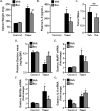Ibuprofen ameliorates fatigue- and depressive-like behavior in tumor-bearing mice
- PMID: 26498217
- PMCID: PMC4679603
- DOI: 10.1016/j.lfs.2015.10.020
Ibuprofen ameliorates fatigue- and depressive-like behavior in tumor-bearing mice
Abstract
Aims: Cancer-related fatigue (CRF) is often accompanied by depressed mood, both of which reduce functional status and quality of life. Research suggests that increased expression of pro-inflammatory cytokines is associated with skeletal muscle wasting and depressive- and fatigue-like behaviors in rodents and cancer patients. We have previously shown that treatment with ibuprofen, a nonsteroidal anti-inflammatory drug, preserved muscle mass in tumor-bearing mice. Therefore, the purpose of the present study was to determine the behavioral effects of ibuprofen in a mouse model of CRF.
Main methods: Mice were injected with colon-26 adenocarcinoma cells and treated with ibuprofen (10mg/kg) in the drinking water. Depressive-like behavior was determined using the forced swim test (FST). Fatigue-like behaviors were determined using voluntary wheel running activity (VWRA) and grip strength. The hippocampus, gastrocnemius muscle, and serum were collected for cytokine analysis.
Key findings: Tumor-bearing mice showed depressive-like behavior in the FST, which was not observed in mice treated with ibuprofen. VWRA and grip strength declined in tumor-bearing mice, and ibuprofen attenuated this decline. Tumor-bearing mice had decreased gastrocnemius muscle mass and increased expression of IL-6, MAFBx and MuRF mRNA, biomarkers of protein degradation, in the muscle. Expression of IL-1β and IL-6 was also increased in the hippocampus. Treatment with ibuprofen improved muscle mass and reduced cytokine expression in both the muscle and hippocampus of tumor-bearing mice.
Significance: Ibuprofen treatment reduced skeletal muscle wasting, inflammation in the brain, and fatigue- and depressive-like behavior in tumor-bearing mice. Therefore, ibuprofen warrants evaluation as an adjuvant treatment for CRF.
Keywords: Cancer; Depression; Fatigue; Ibuprofen; Neuroinflammation.
Copyright © 2015 Elsevier Inc. All rights reserved.
Figures




References
-
- Minton O, Alexander S, Stone PC. Identification of factors associated with cancer related fatigue syndrome in disease-free breast cancer patients after completing primary treatment. Breast cancer research and treatment. 2012;136:513–520. - PubMed
-
- Berger AM, Abernethy AP, Atkinson A, Barsevick AM, Breitbart WS, Cella D, Cimprich B, Cleeland C, Eisenberger MA, Escalante CP, Jacobsen PB, Kaldor P, Ligibel JA, Murphy BA, O'Connor T, Pirl WF, Rodler E, Rugo HS, Thomas J, Wagner LI. Cancer-related fatigue. Journal of the National Comprehensive Cancer Network : JNCCN. 2010;8:904–931. - PubMed
Publication types
MeSH terms
Substances
Grants and funding
LinkOut - more resources
Full Text Sources
Other Literature Sources
Medical
Miscellaneous

